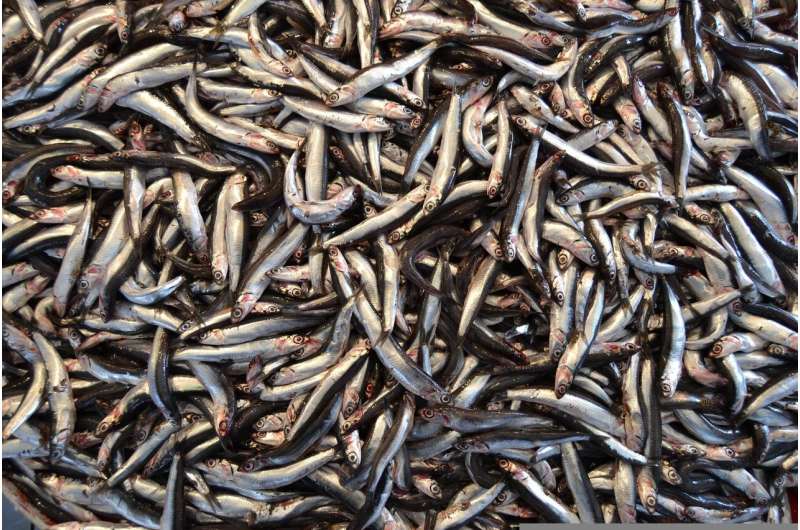This article has been reviewed according to Science X's editorial process and policies. Editors have highlighted the following attributes while ensuring the content's credibility:
fact-checked
trusted source
written by researcher(s)
proofread
Mating anchovies stir up the sea as much as a major storm—and it's good for the environment, too

Why would oceanographers ever care about anchovies having sex? We do because these small fish can help mix different layers of the ocean when they mate. This circulates nutrients, oxygen, and greenhouse gases around different layers of the ocean, thereby sustaining the ecosystem.
Mixing layers of the ocean vertically requires energy. Most of this energy is provided by winds and tides. However, research that was conducted in 1966 found a mismatch between the energy required for mixing and the energy provided by available sources.
This prompted an intriguing question: can swimming animals such as fish and crustaceans fill the energy gap and contribute to ocean mixing?
After decades of mixed and extremely scarce evidence, the oceanographic community came close to reaching a verdict on the topic in 2019. A study conducted by an American researcher called Eric Kunze concluded that biological mixing is extremely unlikely to happen.
The rationale for this conclusion is simple. Marine swimmers do create some turbulent eddies as they move around, but these eddies are too small to cause any substantial vertical mixing. Whirls shed by marine swimmers are so small that they are instead dissipated as heat due to friction between water molecules.
But in a study published in 2022, my colleagues and I challenged this conclusion. Our findings show that biological mixing can happen under certain circumstances.
A surprising observation
In July 2018, our team left the coast of Galicia in north-west Spain on a mission to understand if variations in ocean mixing conditions were to blame for the frequent occurrence of harmful algal blooms that threaten the region's thriving mussel aquaculture industry. We measured water turbulence along with various ecological indicators every 30 minutes for 15 consecutive days.
We monitored turbulence by measuring fluctuations in the velocity and temperature of water at very small scales. These fluctuations are an indication of the intensity of turbulent motions and mixing, respectively. To our surprise, we detected extremely high levels of turbulence every night, at a level similar to that caused by a major storm.
But, at the time of our study, the weather was calm, and tides were weak. So what was happening? The key to unraveling this mystery came from the casual observation of screens in the lab onboard our research vessel. These screens show signals from the ship's echo sounder, an instrument designed to detect the presence of fish.
No one was paying much attention initially since we were—in principle—not interested in fish. However, the acoustic measurements revealed very strong echo signals that coincided with our strong nighttime turbulence measurements. This suggested that the strong nighttime turbulence was related to the presence of fish.
The obvious solution was to capture the fish. We used some of the small bongo-shaped nets designed to capture microscopic algae.
What we found in the nets caught us by surprise. They were full of thousands and thousands of tiny fish eggs, probably belonging to European anchovies.
The circle was closed, the mystery solved. Hundreds of anchovies aggregated around our sampling station every night to mate and fertilize their eggs. In their nightly frenzy, they created the strong turbulence that we measured.
Reviving the 'biomixing' controversy
However, an important question was still unanswered. Were the small but energetic water motions created by the libidinous fish capable of mixing the different ocean layers together?
To answer this question, we examined the millimeter-scale temperature signals from our turbulence profiler. We found that the small-scale temperature fluctuations were more than ten times larger during the night, when lively anchovies were around than during the day. Biological mixing was indeed happening beneath our feet.
We believe that the explanation for our unique finding is related to a fundamental aspect of the physics of turbulence rather than to the sexual preferences of anchovies.
The water column in our study region shows very sharp vertical variations of water properties, referred to as "vertical stratification". Water layers displaying different properties are thus relatively "thin", meaning that the small-scale motions created by the fish can mix them together. This contrasts with previous studies that have been conducted in more open ocean regions where stratification is usually weaker.
Our fortuitous observation proved the longstanding conjecture of biologically driven mixing of the ocean. However, our finding remains an isolated observation.
There is much work to do to assess the significance of biological mixing for the local ecosystem. But one thing is for sure: the biological mixing controversy will stick around for much longer than we would have expected a few years ago.
Provided by The Conversation
This article is republished from The Conversation under a Creative Commons license. Read the original article.![]()



















